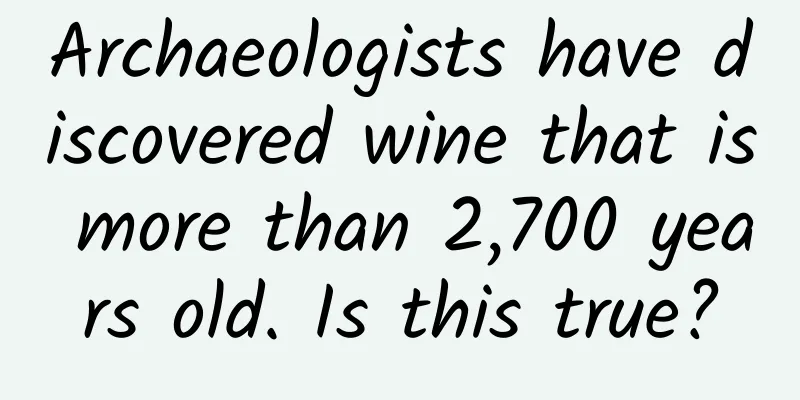Archaeologists have discovered wine that is more than 2,700 years old. Is this true?

|
Archaeologists have discovered wine that is more than 2,700 years old. Is this true? Recently, the scientific archaeological team of the University of Chinese Academy of Sciences and the Shanxi Provincial Institute of Archaeology discovered fruit wine remains in the Beibai'e Cemetery in Yuanqu, Shanxi, filling the historical gap of fruit wine in the pre-Qin period from a physical perspective. This is the earliest known evidence of fruit wine in East Asia, dating back more than 2,700 years, and provides important information for studying the politics, rituals, culture, burial customs and winemaking technology of the society at that time. It is not easy to "find" wine from archaeological sites. After more than 2,700 years of history, it is difficult to find liquid wine, and only traces of it can be found in the alcohol content of some objects. The original alcohol, aldehyde, ketone, ester and other substances in these found wines have generally been lost, macromolecular substances often undergo degradation, and the organic matter is mainly fatty acids, organic acids, amino acids and phenols. How to find ancient wine? How to identify wine information from archaeological remains has always been the most important scientific issue in the field of ancient wine. The study of wine remains requires the mutual support of micro-evidence and archaeological background, and when necessary, it is necessary to use ethnography and ancient documents to answer related archaeological and scientific and technological history questions, such as the function of early pottery, the origin and development of winemaking technology, the spread of wine and wine culture, the role of wine in the process of social complexity, and the use of plants and animals by our ancestors. In terms of scientific and technological means, domestic and foreign academic circles mainly explore the "hidden information" of ancient winemaking from the perspectives of biomarkers, plant microfossils and DNA. In the 1990s, Professor McGovern of the United States pointed out that some organic acids can be used as markers for wine remains, such as tartaric acid for wine and oxalic acid for beer. Based on this, he identified the earliest known wine (Hajji Firus site in Iran) and the earliest beer (Godin Tepe site in the Mesopotamian Basin). In the early 21st century, American Professor McGovern conducted research on wine remains in several archaeological sites in China and believed that the Jiahu ancestors had begun to make wine 9,000 years ago, and the Longshan culture ancestors had begun to make mixed wine 4,500 years ago. The academic community has conducted a lot of research using organic acids such as tartaric acid and oxalic acid as wine markers. For example, using tartaric acid and syringic acid as wine markers, it was discovered that the burial custom of Tutankhamun's tomb was to place red and white wines separately. Plant microfossils are also used to obtain potential information about wine remains. For example, the degree of damage to starch grains was first used in the study of the Egyptian beer production industry. In recent years, Professor Liu Li's team at Stanford University has identified artificial brewing through the gelatinization of starch grains. They have combined the presence of oxalic acid and ethnographic analogies to confirm the barley beer brewing behavior of the ancestors of Mijiaya in Shaanxi 5,000 years ago. Some scholars use grape spores as an indicator of wine to prove the function of amphorae in Egypt, Rome and other places. In addition, stable isotope analysis, DNA analysis and other methods are also used to reveal information such as raw materials, origin, variety, and strains. The thousand-year-old wine still smells delicious Liquor remains have long been found in archaeological sites in my country, such as ancient wine in a porcelain pot unearthed from a Liao Dynasty tomb in Shenyang in 1974, and several kilograms of fragrant Warring States wine unearthed from the Tomb of the King of Zhongshan in Hebei in 1977. In the early 1970s, Mr. Guo Moruo, President of the Chinese Academy of Sciences, personally tasted the thousand-year-old wine unearthed from the Mawangdui Han Tomb in Changsha, which became a legend for a while. In contrast, the research on solid remains of wine led by domestic scholars started relatively late. It was not until 2005 that tartaric acid was extracted from soil samples from the inner wall of bronze wine vessels, indicating that tartaric acid also exists in grain wine and is not a specific indicator of wine. As a country with a rich wine culture, China has developed a variety of wine products in its nearly 10,000-year history of winemaking, including wine (qujiu), li (guyajiu), chang (xiangcaojiu), lao (sweet rice wine), and shaojiu (distilled liquors such as baijiu). However, corresponding archaeological research is rare. |
<<: How does depression destroy a person?
>>: Keeping with the Milky Way
Recommend
15,000 applications and 1 billion ecological devices, pure Hongmeng completely rewrites the mobile phone operating system market landscape
On October 22, at the Huawei HarmonyOS Night and ...
Share 4 websites that make you rich quietly, and see different Taobao customers
Let me share with you 4 websites that can help you...
Automatic platform for re-trading old projects, with unlimited daily income
Old project replay automatic hanging platform, si...
The difference between VR and AR technology: application differences lead to two different concepts
Regarding virtual reality (VR) and augmented real...
Ministry of Industry and Information Technology: my country's lithium battery production will exceed 400GWh in the first half of 2023, a year-on-year increase of more than 43%
In the first half of 2023 , China's lithium-i...
There are new discoveries on the Terracotta Warriors!
The School of Cultural Heritage of Northwest Univ...
Shell wrapped in meat, shell wrapped in meat... It is a close relative of the ancient squid, and eventually grows into "streaky meat"
In nature, animals' hard structures basically...
Living alone for 16 years, without mating, it gave birth to a child
After living alone for many years and never seein...
Why do we need to build an Apple bidding intelligent delivery platform?
It was somewhat difficult to adapt to the transit...
6 times of submission for review, our application's review journey!
This is the third time I have woken up in the mid...
Retweet! This is a day worth remembering!
On August 16, 2016, the world's first quantum...
Should companies develop WeChat mini-programs?
Should companies develop WeChat mini-programs? Do...
OMG, Musk's robot came out without clothes
Because of Transformers, people have an inherent ...
How can ordinary people make their first million through marketing?
This is a thought process that teaches you how to...
What is the sugar-acid ratio of the popular "fruit ring"? It tastes good but it also needs to be in the right amount
As summer approaches, the dazzling array of fruit...









